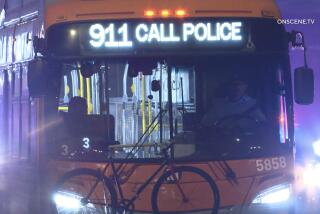A Reality Ride on the Public Transit That Matters
I was running late that morning. But the number 83 bus was running even later, by about 15 minutes. The bus bench where I waited for it was alarmingly close to the teeming street, but at least it was a place to sit, something I didn’t have when I finally boarded the lollygagging bus.
Until this week, I don’t think I had set foot aboard a Los Angeles bus since before the system changed its name from RTD to MTA. I have ridden the Paris metro, the London tube and the Moscow subway more often than I have the buses of Los Angeles.
Some of the excuses are mine--I need a car for work, I have a second job, I get motion sickness on an escalator and, frankly, I can afford not to ride the bus. And some of the fault is the MTA’s, for leaving its fleet of buses to get older and junkier and more crowded as it invests in razzle-dazzle transit-of-
the-future--at best splendidly visionary, at worst the fantasies of a gambling addict feeding his kids on macaroni and promises until the big score comes in.
So we find ourselves in transit’s transitional years, supposedly being weaned from stinking, lurching, sardine-seating buses to a future of swift, clean, quiet subways and trains.
But each day, more than a million people across the county--more than nine of every 10 MTA patrons--still take a bus to get to work, to school, to the doctor’s office. Groups acting on bus riders’ behalf went to a federal judge about this, and the judge appointed a special master who took the MTA by its double-breasted lapels and said, “Listen, pal. Buy 532 more buses, and I mean new, clean-fuel buses, or you’ll be bunking with capital-T trouble.”
The MTA has gone to court, boo-hooing that it can’t possibly do so much so soon, that it already plans to spend a billion for buses, and that more would mean deep-sixing some big projects in the works.
Maybe so. But the MTA has already frittered away so much goodwill and credibility that few are willing to listen to its woes. It has dug itself into a fiscal hole far more efficiently than it has dug its $300-million-
a-mile subways; it is $7 billion in debt, and must spend nearly a third of its annual operating budget just paying the equivalent of the interest on its maxed-out credit cards.
With a history of boneheaded six-figure budgets for doughnuts and catering and entertainment, fact-finding trips abroad to inspect Italian granite and English bricks for a sumptuous 26-floor headquarters, a Red Line that goes nowhere near Dodger Stadium, and a Green Line that stops more than a mile short of the airport, the MTA couldn’t have made itself more unsympathetic if it had put Saddam Hussein on the payroll.
So that’s what got me aboard a bus this week: Why, the poor MTA--it needs my $1.35.
*
The saying goes that nobody rides the bus in this town, which really means that you’re nobody if you ride the bus in this town. Of all the people on my round-trip bus rides, only five shared my skin color. This is of a piece with the civil-rights element of bus riders’ lawsuits--that the burden of bad buses falls most heavily on the poor and people of color.
I felt like a tourist. I suppose I could have edified myself with the urban scenery, except that the bus windows were so overscratched with graffiti that I could have seen better through the screened windows of the bus from the Twin Towers jail. Even if the windows had been immaculate, I couldn’t have seen past the people standing in the aisles--as few as four, as many as 15. Any more than 15 “standees” on a 20-minute ride violates more than a court order--it violates the promise of 20 years of transit taxing and spending: build to attract those who might ride, maintain to serve those who must ride.
*
In economics they teach the either-or choices of governments’ finite budgets: guns or butter, defense or domestic needs.
Surely the MTA, beneficiary of federal largess, of a penny-on-the-dollar county sales tax, could have given us both guns and butter, decent bus service and future transit, had it not been for waste and folly and politicking on a scale that would have landed any individual in bankruptcy court or jail.
I like subways and trains, and would take them to work if they worked. Angelenos, despite our reputation as a one-man-one-car democracy, seem to like them too, voting twice since 1980 to tax ourselves to build better transit. There is more there than nostalgia for the remembered efficiencies of the Pacific Electric system.
Me, I have the luxury of choices. When I finish writing this and it’s time to head home, I’m calling a cab.
*
Patt Morrison’s column appears Fridays. Her e-mail address is: patt.morrison@latimes.com.
More to Read
Sign up for Essential California
The most important California stories and recommendations in your inbox every morning.
You may occasionally receive promotional content from the Los Angeles Times.











